Jamaica
Rastafarians, Reggae, Dreadlocks & Jerk. Exploring The Longstanding Resort-Heavy Jewel In The Caribbean Tourist Industry’s Crown
Traffic light service in Kingston, Jamaica. May 13, 2015
Jamaica, the land of Rastafarians, reggae, ganja, jerk, dreadlocks, Bob Marley & Usain Bolt and the Caribbean’s original all-inclusive resort hive; it’s probably the most famous Caribbean resort island of them all, especially with Americans. I hadn’t realised how dependent the island was on the tourist dollar. I guess you wouldn’t until such time as you do what I did and visit the island. And when I did I was one of the few (it’s all relative, of course) who didn’t arrive in Jamaica on board a cruise ship, one of the few who didn’t fly into Montego Bay’s Sangster International Airport, & one of the few who didn’t call one of the island’s numerous resorts home for the duration of my stay. I’m not claiming to be some sort of independent-travel-in-Jamaica trailblazer but with the country’s tourist industry so geared towards the needs and whims of the package tourist, any kind of independent travel embarked up here, like the clockwise self-drive loop of the 11,000 km² island I undertook, has you really feeling like you’re going against the grain.
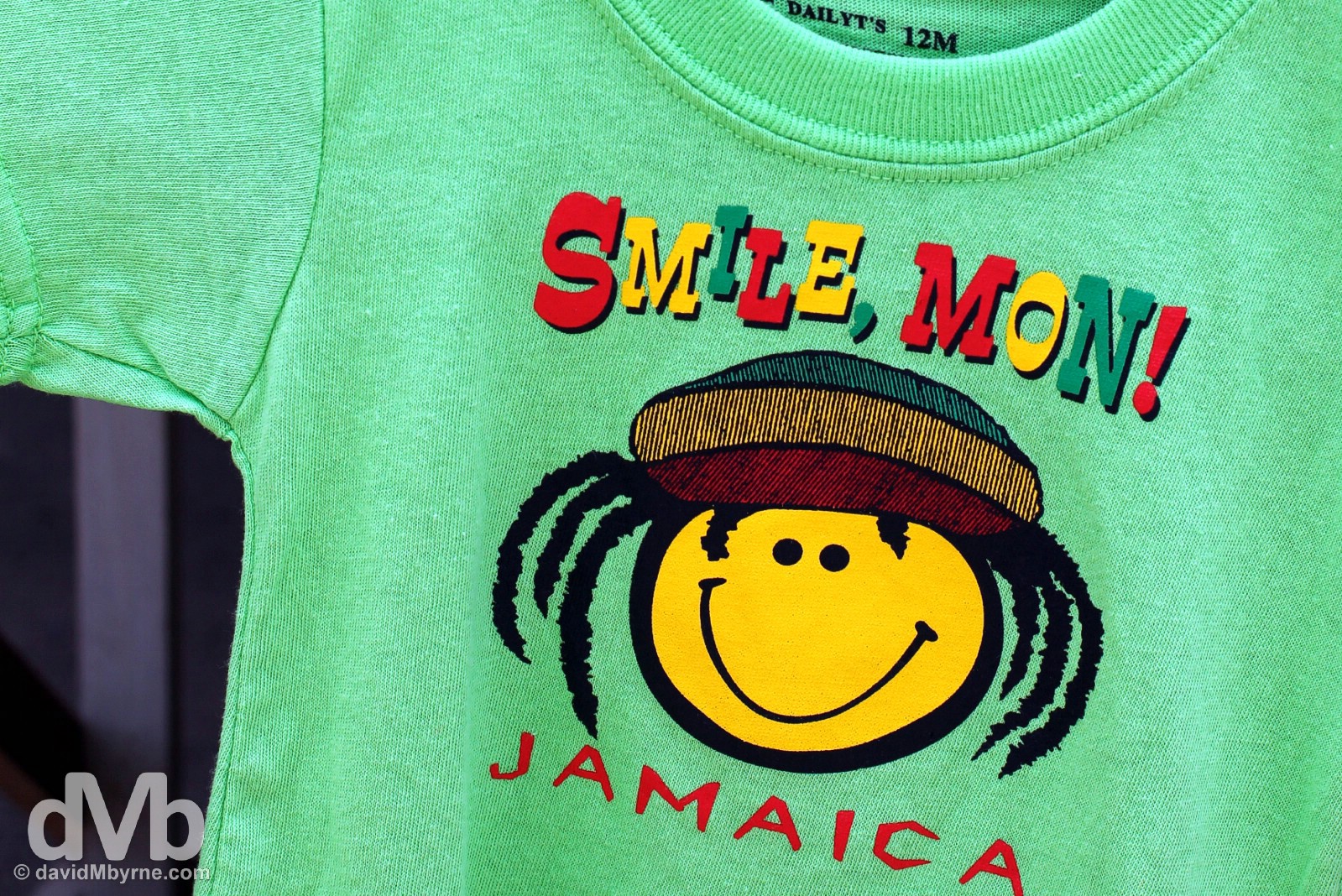
Smile, Mon! Jamaica
BRIEF HISTORY & TOURISM
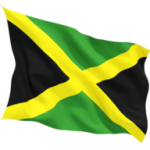 Christopher Columbus landed on the island of Jamaica in 1494 on his second voyage to the New World making contact with the indigenous Tainos, who had arrived some 700-800 years previous, & claiming the island for Spain. Within 3 decades the local population was decimated by the combination of European illnesses & forced labour prompting the Spanish to introduce West African slaves to the island; the majority of Jamaica’s present-day population of 3 million trace their roots back to these African slaves. The English attacked a weakly defended island in 1655 causing the Spanish to retreat to Cuba; Spain officially ceded the island to the British in 1670 as part of the Spanish-British Treaty of Madrid. The British, and off the back of slavery, turned the island into the world’s largest sugar producer during the latter half of the 18th & first half of the 19th centuries. Sugar remained the big earner, helped by the introduction of indentured Indian labourers to fill a labour shortage following the 1834 abolition of slavery. Bananas, too, with exports of those peaking in the late 1920s. Jamaica’s first political party was formed in the late ‘30s sowing the seeds for independence from the UK which came in 1962.
Christopher Columbus landed on the island of Jamaica in 1494 on his second voyage to the New World making contact with the indigenous Tainos, who had arrived some 700-800 years previous, & claiming the island for Spain. Within 3 decades the local population was decimated by the combination of European illnesses & forced labour prompting the Spanish to introduce West African slaves to the island; the majority of Jamaica’s present-day population of 3 million trace their roots back to these African slaves. The English attacked a weakly defended island in 1655 causing the Spanish to retreat to Cuba; Spain officially ceded the island to the British in 1670 as part of the Spanish-British Treaty of Madrid. The British, and off the back of slavery, turned the island into the world’s largest sugar producer during the latter half of the 18th & first half of the 19th centuries. Sugar remained the big earner, helped by the introduction of indentured Indian labourers to fill a labour shortage following the 1834 abolition of slavery. Bananas, too, with exports of those peaking in the late 1920s. Jamaica’s first political party was formed in the late ‘30s sowing the seeds for independence from the UK which came in 1962.
Heavily indebted to foreign banks, today Jamaica is looking beyond the old reliable US of A for foreign investment, especially to China, while (still) very heavily reliant on the tourist dollar; Jamaica was the first Caribbean island to fully realise the potential of tourism and the mark it stole on its regional neighbours in this regard accounts for the relative maturity of its tourist industry today, not to mention the overdevelopment of stretches of its resort-peppered western & northern coasts.
Read all Jamaica location postings in chronological order or jump to specific postings using these links.
SOUTH – The Capital, Cool Highlands & Parched, Untouched Southern Coast || Kingston || Mandeville || Treasure Beach
WEST COAST – Tourists & Resorts || Negril
NORTH COAST – History & Cruise Ships, More Tourists & Resorts || Montego Bay || Falmouth || Dunns River Falls
CARIBBEAN ISLAND HOPPING – Moving On || Onward to Haiti
Jamaica Locations Map
Kingston
Jamaica’s capital & economic & cultural hub, a city of chaos, noise, traffic, humanity, shabby squalor & intimidation.
Kingston, the capital & economic & cultural hub of Jamaica, was my introduction to the island, but only briefly & only after we, Liam my travel buddy and I, landed from Grand Cayman, picked up the hire car and drove from Norman Manley International Airport to the city’s outskirts, a 14 kilometre drive hugging the shores of the world’s 7th largest harbour. Cue the chaos.
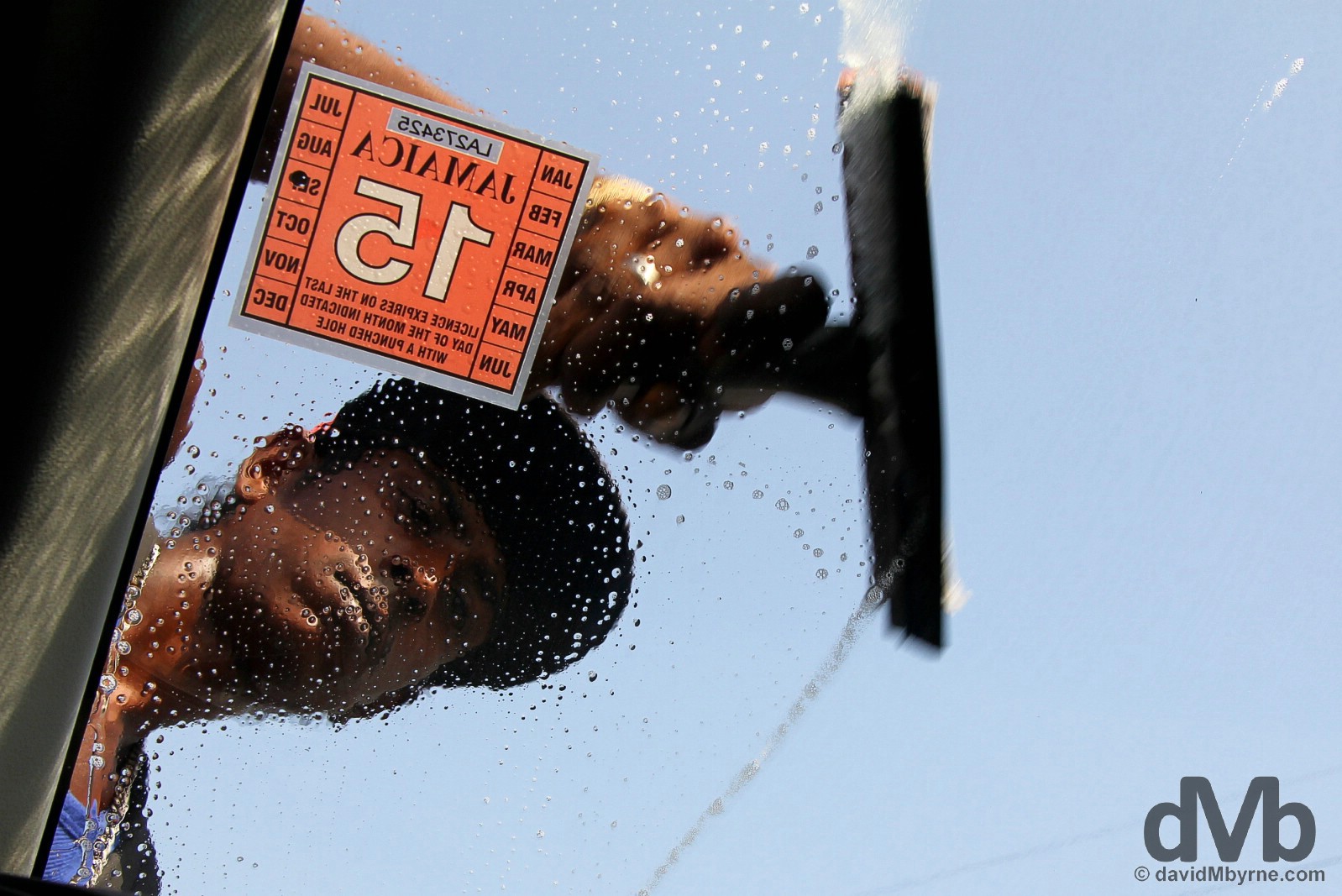
Traffic light service on the Spanish Town Road in Kingston, Jamaica. May 13, 2015. || It is safe to say Jamaica does carry a fearsome reputation before it, and not without merit either; the island has an unenviable high murder rate, although it’s mostly ghetto-related and far from any tourist centres. Kingston is not a tourist centre. There’s not much to see here, a city of chaos, noise, traffic, humanity, shabby squalor & intimidation. It’s not a good introduction to the country & not somewhere that will or should detain you for long, if at all – those interested in the Bob Marley Museum, Trench Town Culture Yard & the National Gallery of Jamaica, the city’s only attractions per se, might find reason to disagree & thus linger. I captured this image at traffic lights while navigating through the frenzied streets of the city in a bid to escape, to find the road out, the Spanish Town Road, my favourite part of Kingston. I did spend more time in the city at the end of my Jamaican loop, including somehow managing to drive my hire car into a human traffic jam in the city’s central market, but I still left Kingston with very little good to say about it.
Mandeville
The island’s cool Central Highland capital, a town devoid of attractions & tourists but heavy on eagle-eyed clampers.
– An old Jamaican saying about driving its road.
It was decided to hire a car for our our time in Jamaica, primarily because of a desire to be mobile & see as much as possible for the limited time we had at our disposal. This coupled with the relative slowness & limitations of public transport, not to mention expense of taxis for short trips, made hiring a car an obvious choice. I’ve driven in some pretty testing environments over the years so I wasn’t perturbed by stories of cavernous potholes on narrow, winding roads, a total lack of signage, or even of the crazed drivers that try to make the country’s diabolical roads their own, totally belying their off-the-road laid-backness. Yes, we could, and did, handle all of that. But we never took getting clamped into consideration.
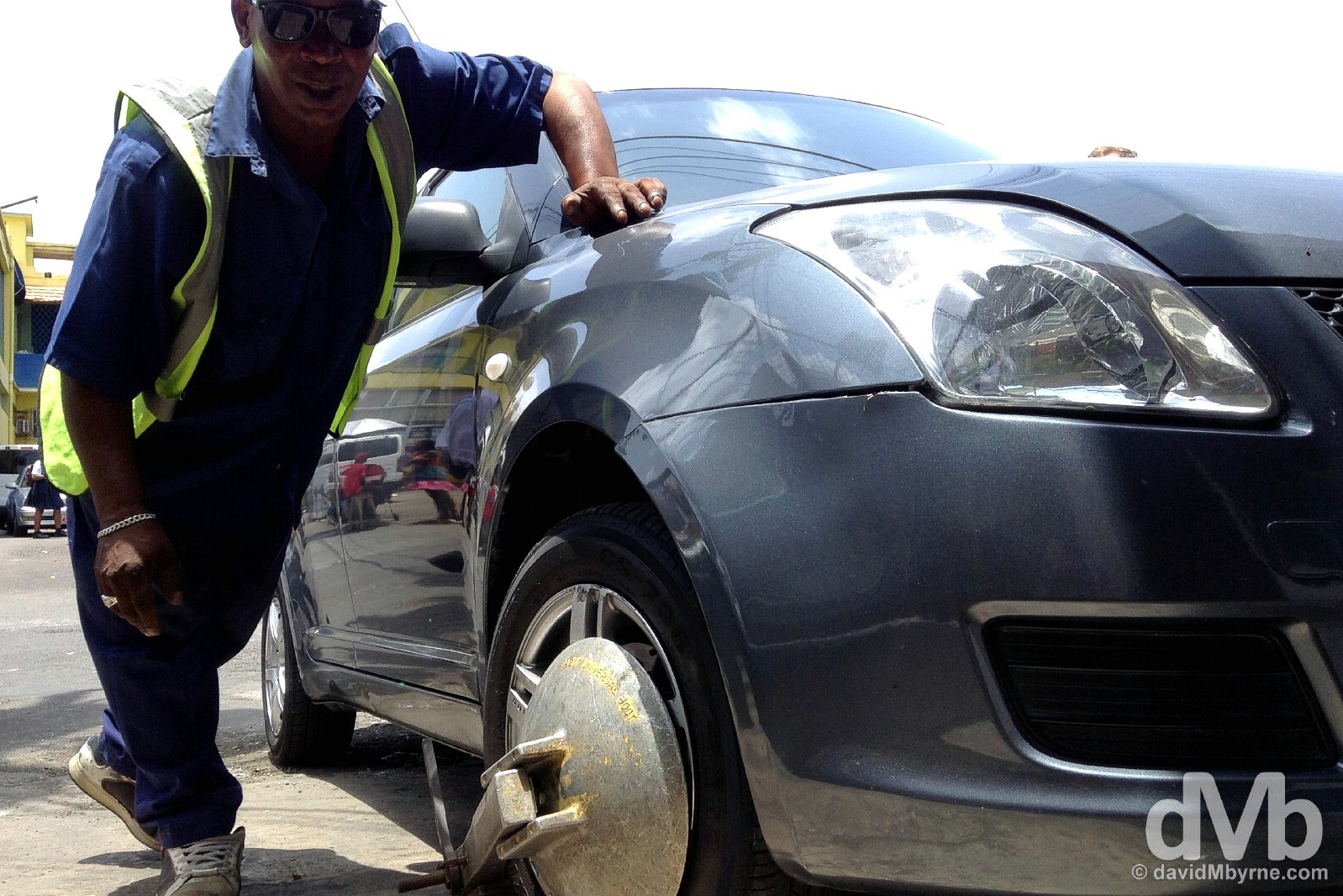
Clamped. The clamp & the clamper on the streets of Mandeville, central Jamaica. May 13, 2015. || Within a few hours of picking up our little Suzuki Swift in Kingston’s Norman Manley Airport & successfully navigating through the chaotic city from one side to the other, Liam & I were in the central town of Mandeville, the unofficial capital of the so-called cool Central Highlands. Needing an ATM (& food courtesy of the delectable Juici Fried Chicken), we deemed Mandeville, Jamaica’s fifth-largest city & 115 kilometres from the airport, a better pit stop option than Kingston. Obviously a town that sees very few tourists, we stood out like proverbial picks at a wedding. Maybe that drew the clamper’s attention. While walking back to the car in preparation to leave the town for our ultimate destination on this day – Treasure Beach, 50 kilometres away on the island’s southern coast – we joked that we’d probably find the car at best propped up on bricks or at worst gone altogether. I guess given those scenarios discovering us clamped & forking out 2500 Jamaican Dollars (€20) to this guy, who was more than happy to pose for a picture while freeing us up, was tolerable. Missing our flight from the Cayman Islands to Jamaica & being clamped within a few hours of finally getting here. It had been an eventful last few days in the Caribbean.
– Lonely Planet Jamaica
Treasure Beach
Jamaica’s remote & comatosed resort & hassle-free ocean-side retreat, the best place in Jamaica to escape Jamaica itself.
A little over fifty kilometres along tight winding country roads from Mandeville (with an insufficient map & no road signs, we really had no idea if we were going in the right direction, happy to get lost as distances were we to do so were short) and we eventually reached Treasure Beach, probably the place in Jamaica to escape Jamaica itself.
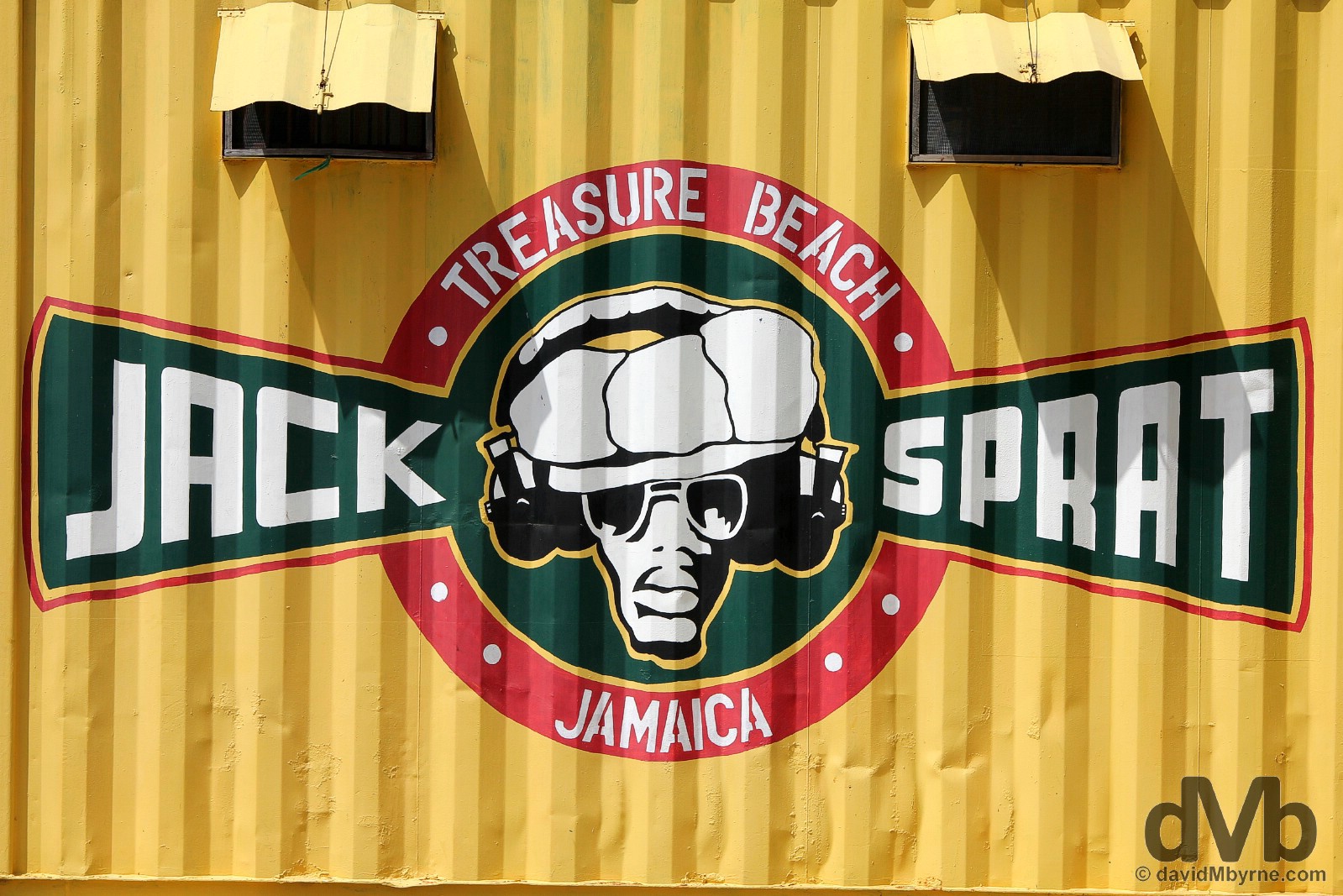
Jack Sprat, Treasure Beach, Jamaica. May 13, 2015. || Buccaneer-sounding Treasure Beach is a generic name for four coves on Jamaica’s parched southern coast – this semi-desert region receives little rain as it’s sheltered by the mountains of the central highlands. Well removed from the urban chaos of Kingston & not even accessible by public transport, it’s the sort of place that presents the laid-back Jamaican scene/vibe that travellers associate with the country. And laid-back it is. There are no resorts here, an unsullied region protected by local strong-spirited communities intent on keeping out the hordes. Crime is rare, tourists rarer; only a trickle of independent off-island visitors ever make it down here and those who do just chill in places like Jack Sprat’s, a well-known, colourful retro-style cafe overlooking the Caribbean Sea.
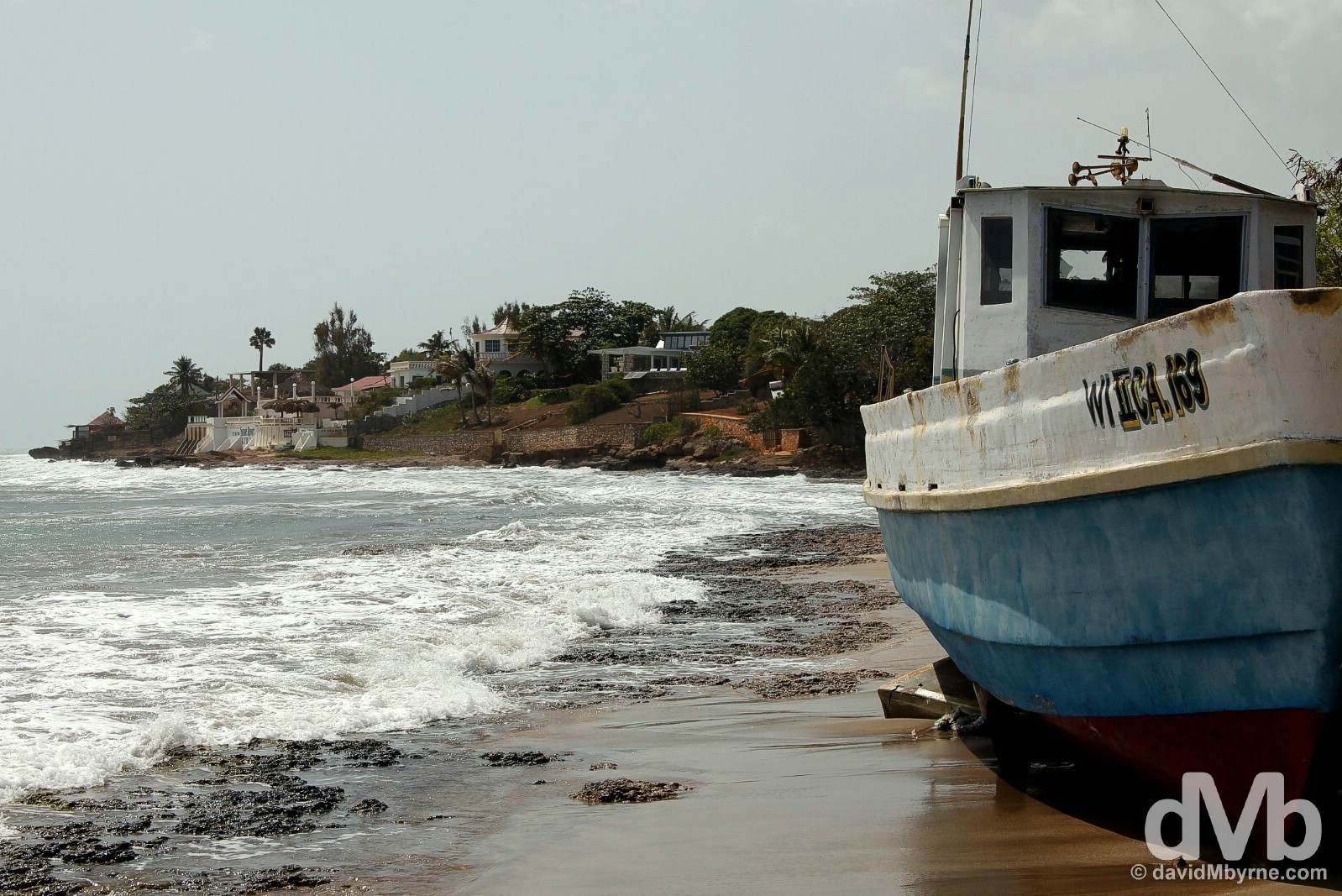
Only one small road connects the sun-kissed southern coast coves & (not ideally suited for swimming) beaches, where you’ll find many a beached & multicoloured wooden fishing boat. Treasure Beach, Jamaica. May 13, 2015.
We intended to overnight in Treasure Beach. That was the plan driving there and that was still the plan upon arrival early afternoon. But comatosed Treasure Beach was just a tad too comatosed for us; chilling is one thing, being bored another. So, and having already driven 170 kilometres, we pushed on for another 100 kilometres, and 2+ hours in the car, for Negril at the extreme west of the island via the mostly coast-hugging A2. A friendly old man sitting outside his abode in Treasure Beach set us off in the right direction, the police en route ensuring we were still on the scent, once they’d given our documents the customary once-over, told us not to speed, told us to watch out for the potholes, and wished us well for the rest of our time in Jamaica. All told it was an eventful day driving the roads of southern & central Jamaica.
Negril
Jamaica’s busy blemished-western-coast party town, the 1970s hippy hive that still draws the hedonistic hordes today who party from one Caribbean-best sunset to the next.
Stretching along more than 16 kilometres of shoreline on the island’s western tip, Negril is Jamaica’s pleasure-seeking party resort town. This is where Jamaican tourism first made it big. As recently as the late 1950s Negril was a small fishing village. Then came a road (in 1959) followed by electricity, the telephone & the hippies, lured here in the ‘70s thanks to killer beach sunsets & an anything goes liberalism that still draws the hedonistic hordes today. Negril, where the waft of ganja is never far away; seemingly Jamaica’s best marijuana is grown nearby. (I was surprised to learn that, and while widely available, marijuana is strictly illegal in a country so closely associated with it).
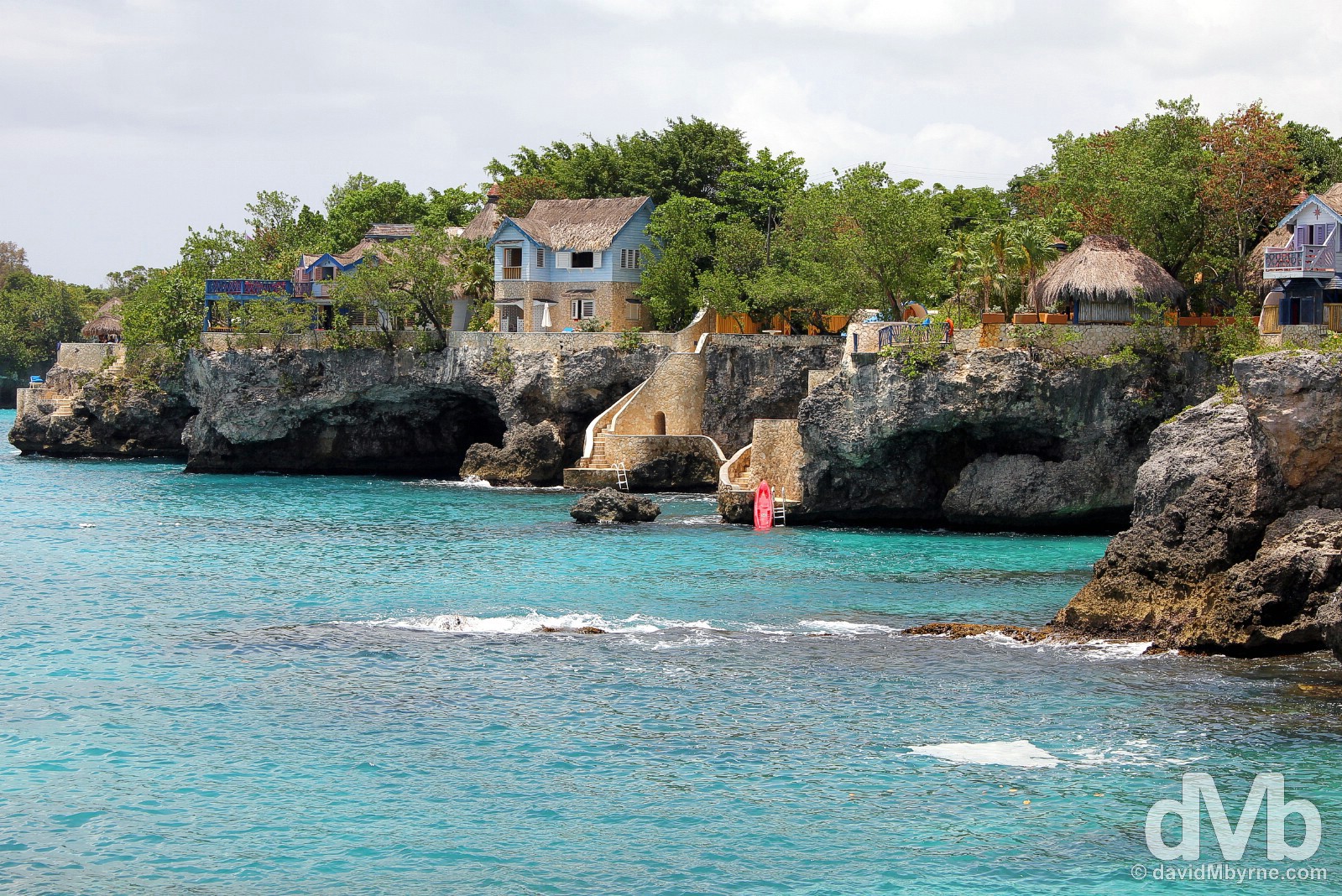
A section of the coast outside Negril, Jamaica. May 14, 2015. || Nearly half a century of development has taken its toll on Negril & its coastline is now 16 kilometres of coast-hugging developments. This is a picture captured from the cliff-hugging grounds of the 1894 Negril Lighthouse. Something of a local landmark, the 20 metre-high beacon is located a few kilometres outside Negril proper just off West End Road and along the coast from South Negril Point, the westernmost point of mainland Jamaica. Despite the lack of beaches, this is a popular place to cool down with no shortage of cliff perches from which to hurl yourself into the azure ocean below, not to mention enterprising devil-may-care Rastas willing to do it for you & your camera. Just don’t forget to tip them.
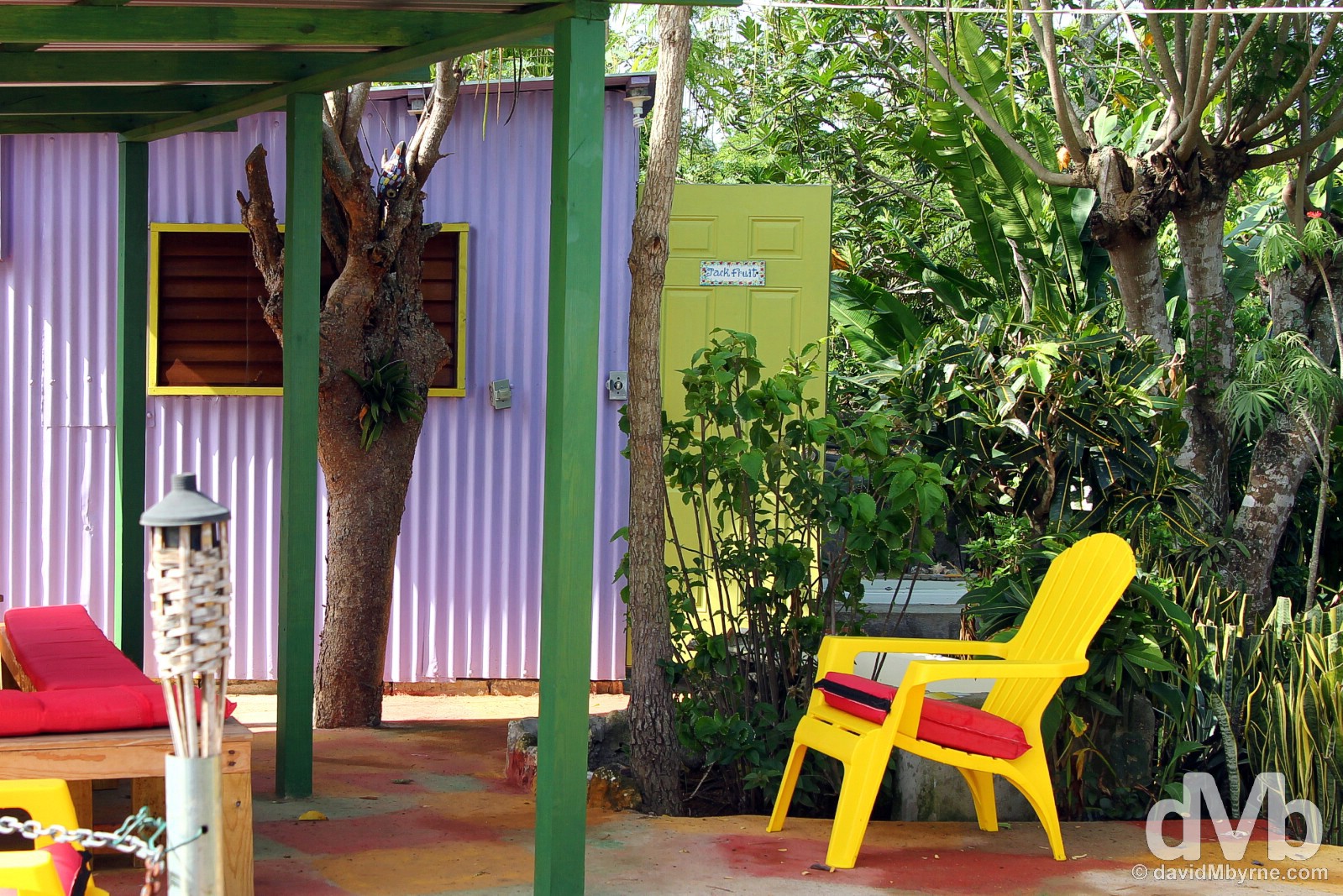
Judy House, Negril, Jamaica. May 14, 2015. || Negril was where I first slept in a shed, a coulourful, corrugated shed called Jack Fruit, not somewhere to linger in the heat of the day. It was one of the accommodation options at Judy House. Secluded & set in a lush tropical garden perched on a hill west of Negril, it has to be one of the more colourful budget accommodation options around.
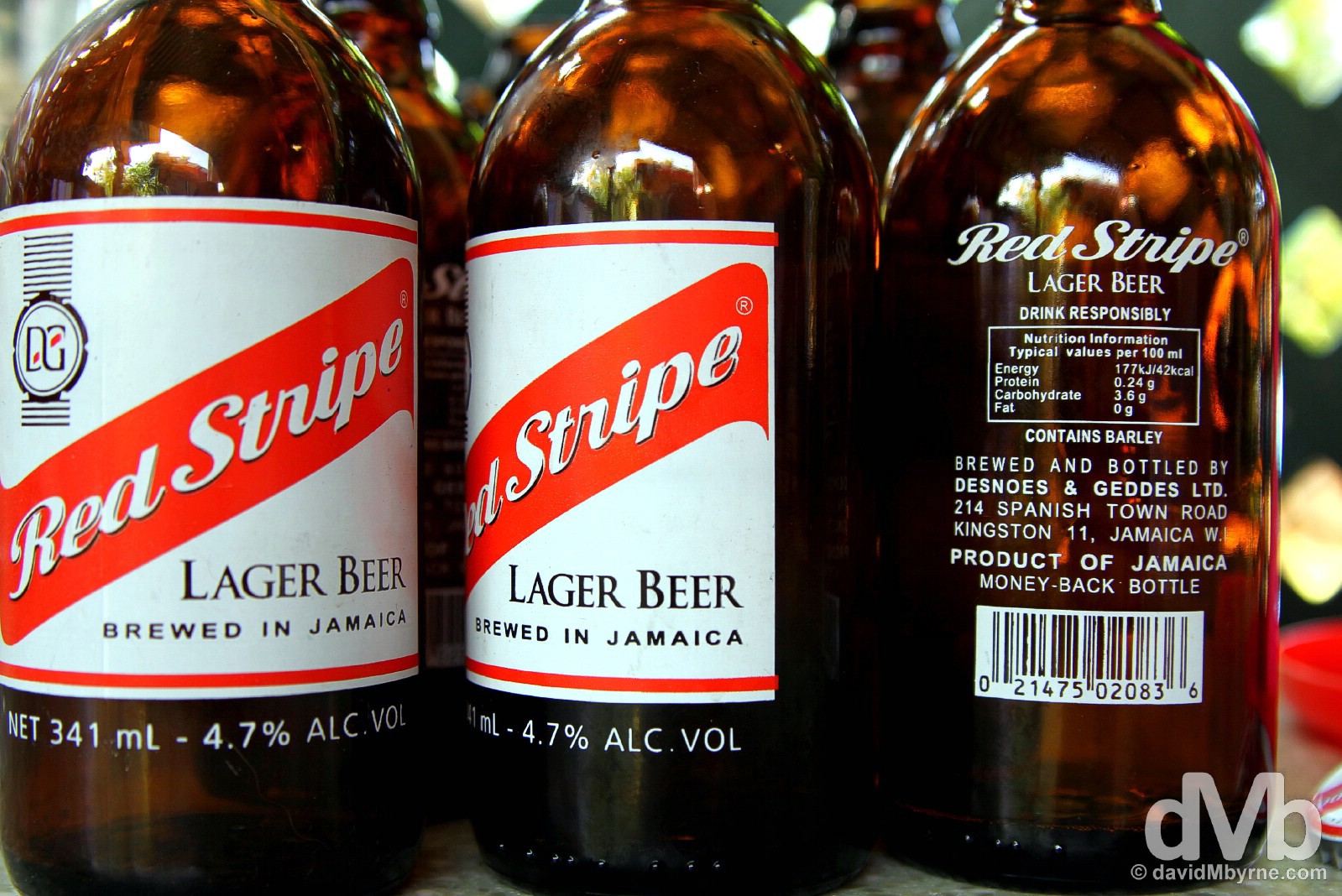
Red Stripe, Judy House, Negril, Jamaica. May 14, 2015. || Negril is also where I had my first Red Stripe, Jamaica’s most famous beer. It goes great with spicy jerk chicken. Jamaica’s signature dish was sampled in a shack off West End Road, jerk being both the name for a tangy/spicy marinade/spice rub for meats & fish, & for the actual method of smoking them slowly over a fire of pimento wood.
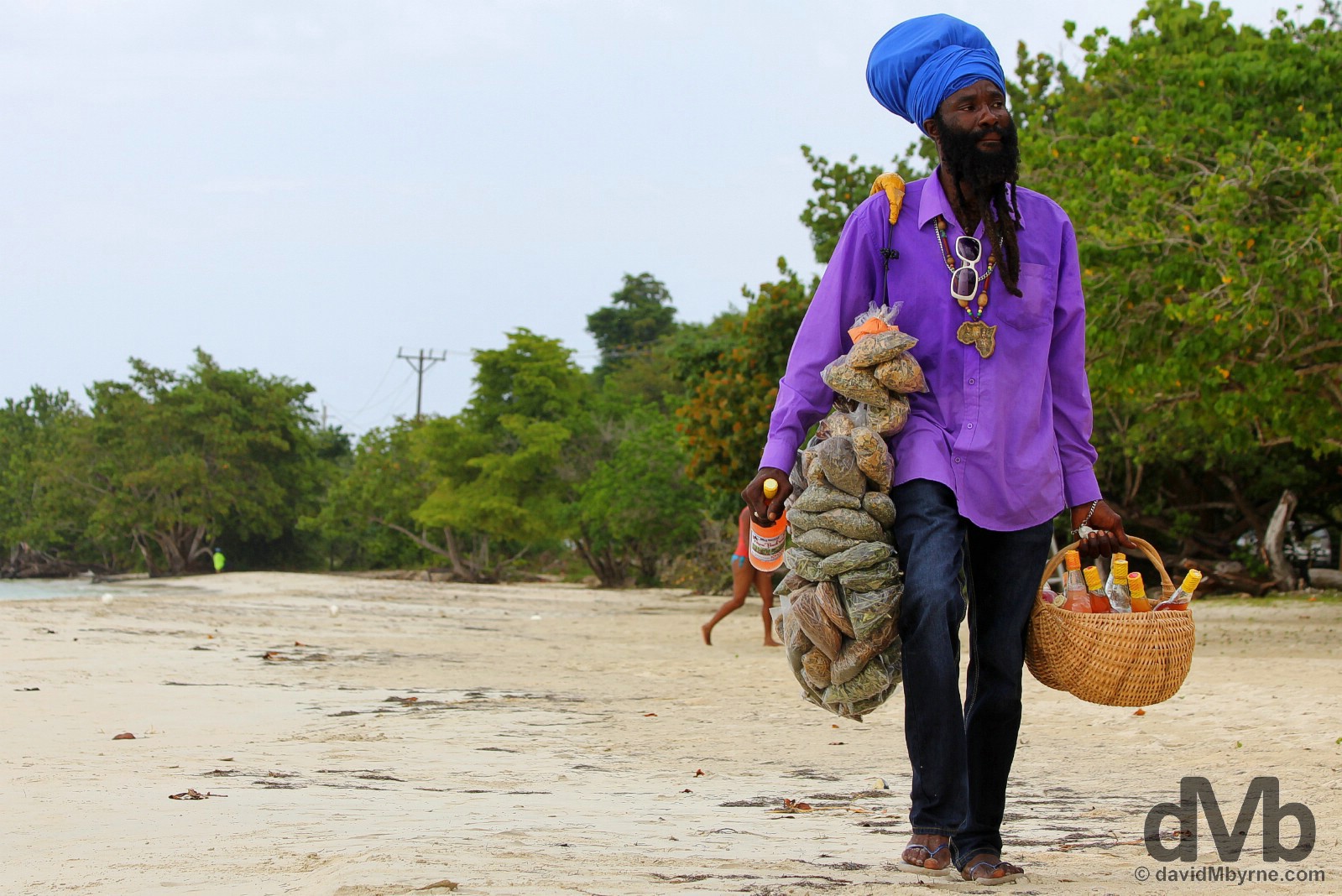
Long Bay Beach Park, Negril, Jamaica. May 14, 2015. || Given its status as something of a traveller’s centre, Negril boasts easily the highest concentration of touts in Jamaica. Most of them are harmless and can be found lurking here on Long Bay, a.k.a. Seven Mile Beach – despite the name, it measures only a little over 4 miles long, still easily Jamaica’s longest beach. Almost continuously cluttered with restaurants, bars, cafes, nightspots and water sport shacks, it is billed as the finest stretch of white sand in the country. According to some, the west-facing beach is also home to the most famous sunset in the Caribbean, something we didn’t experience while in town; inclement weather meant we saw a lot of rain and missed seeing the beach at its finest.
Montego Bay
Jamaica’s second and most polished city, MoBay is home to a busy cruise ship terminal and the country’s largest airport, one that welcomes 80% of all visitors to the country.
It’s a short 80-kilometre, 90-minute drive from Negril to Montego Bay along the coastal A1. Home to the country’s largest airport and a busy cruise ship terminal, MoBay, as everyone calls it, is Jamaica’s second city. I hadn’t heard too many positives about it prior to arrival (Lonely Planet describes it as ‘an unremarkable city of clamour and traffic’) but there’s a certain polished look to MoBay that’s absent elsewhere. It’s easily the most developed Jamaican city or town, primarily because of its gateway status – 80% of visitors choose it as their port of entry to the country, almost 100% of which are destined for one of the numerous beach resorts outside the city’s commercial core or lining the island’s northern coast east of the city.
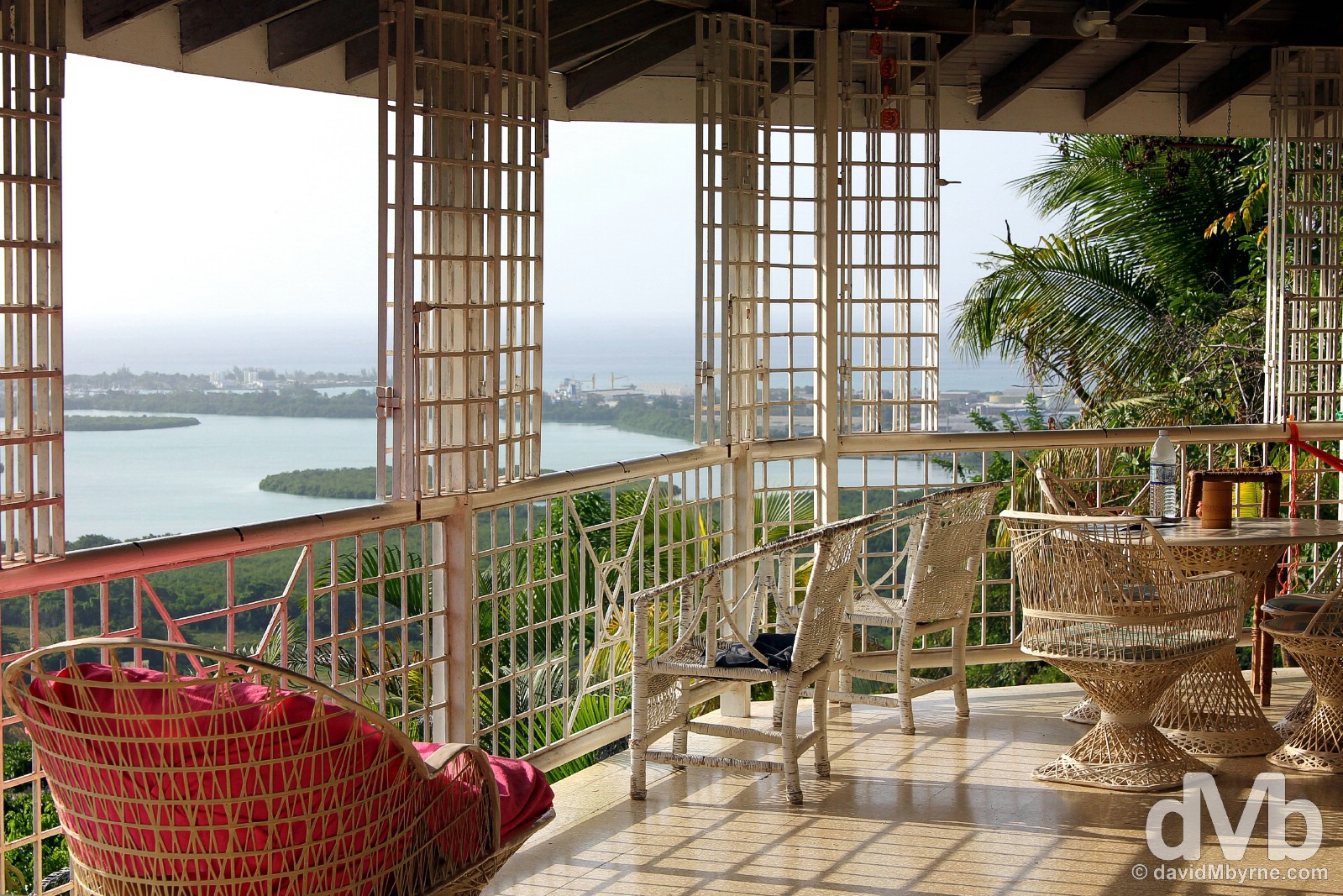
Cedar Ridge Lodge Inn, Montego Bay, Jamaica. May 14, 2015. || Another reason I liked MoBay was the airy veranda of the Cedar Ridge Lodge, my home in the city. Offering amazing views down over Jamaica’s second city, it’s somewhere that I wished I could have lingered longer.
Falmouth
It had fresh running water before NYC did. Historic Falmouth, an open-air museum of colonial wooden architecture & Jamaica’s best-preserved town.
Bidding a teary Liam adieu at MoBay’s Sangster International Airport, I continued on my merry way along Jamaica’s northern coast, a region that is integral to the Jamaican tourist industry – the northern coast outside MoBay is dotted with all-inclusive, high-end resorts hidden behind massive walls. I passed them all by and after about 30 kilometres I took a left turn off the coastal A1 to deviate into historic Falmouth, somewhere that shouldn’t be bypassed.
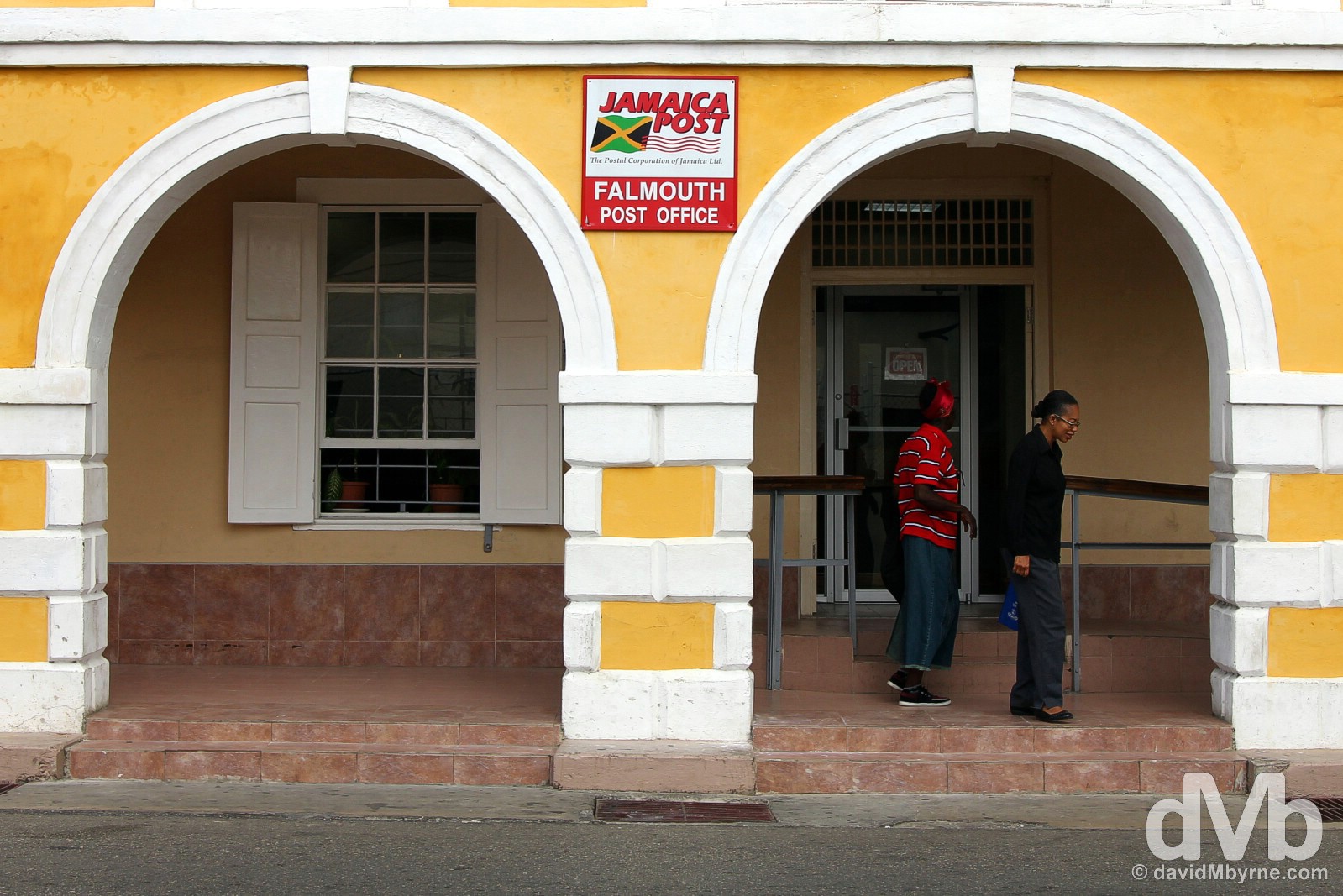
Falmouth, Jamaica. May 15, 2015.
– Lonely Planet Jamaica
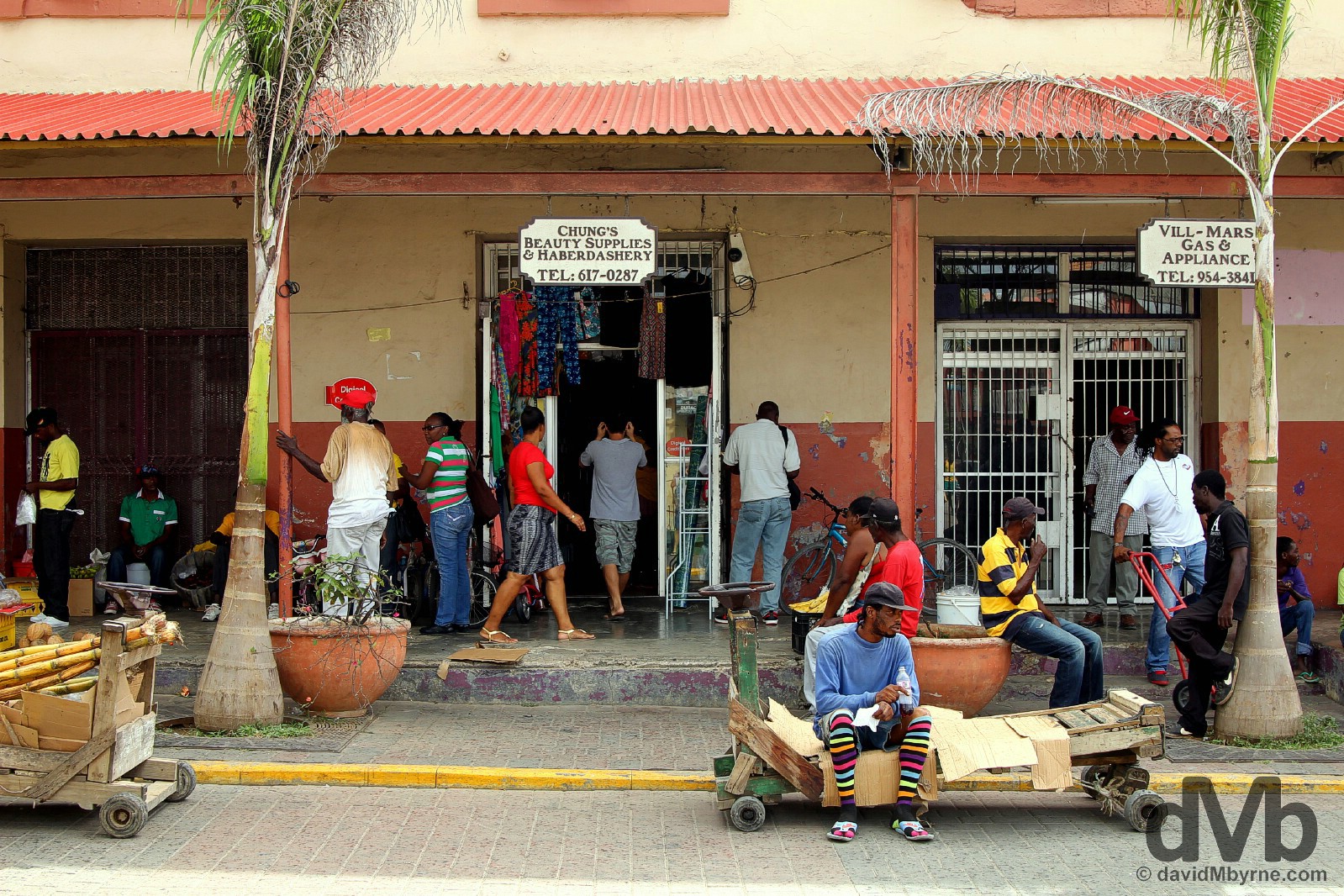
Off Water Square at the east end of Duke Street in Falmouth, Jamaica. May 15, 2015. || For history in Jamaica it’s hard to beat Falmouth, an open-air museum of colonial wooden architecture & the country’s best-preserved & historic town where colourful wooden shop fronts are attractively dishevelled relics of the past. It’s an awesome place to explore with Water Square its heart & the site of many historic structures and placards detailing some of the town’s historic firsts – among other titbits I was to learn that Falmouth had fresh water before New York City did. Go Falmouth!
I had a quick scoot around Falmouth. If time is limited that’s all that’s needed and it’s perfect if, like me, you’re wary of getting clamped (once bitten, twice shy). Chances are if you do visit Falmouth, it’ll likely be as part of a cruise – the town is now the proud owner of a cruise ship terminal, Jamaica’s third after MoBay and Ocho Rios further east.
Bob Marley || The (Unavoidable) Soundtrack Of A Jamaican Road Trip
It’s not just carefree travellers in carefree traveller hangouts the world over who listen to Robert Nesta ‘Bob’ Marley ad nauseam. Jamaicans do too. My abiding memory of driving around Jamaica, including the 70-kilometre stretch of the northern A1 between Falmouth & Ocho Rios, is Bob Marley on the radio interspersed by motormouth DJs (that you need to concentrate intently on in order to understand their verbalisations) interspersed by annoying adverts for Digicel, the island’s very popular, very visual & very vocal mobile phone network provider. Bob, who emerged in the mid-1960s at the height of the ska era in Jamaican music to become, as Lonely Planet claim, the first global superstar of the developing world, is, and not surprisingly, all over the Jamaican airwaves; he’ll be wherever you decide to go when turning the radio dial while exploring the roads of Jamaica.
– Lonely Planet Jamaica
Robert Nesta 'Bob' Marley (February 6 1945 - May 11 1981)
Bob was a singer-songwriter and one of the first and most famous Jamaican musicians to make the transition into the mainstream. He was the rhythm guitarist and lead singer for the ska, rocksteady and reggae band Bob Marley & The Wallers (1963-1981). Marley remains the most widely known and revered performer of reggae music and is credited with helping the spread of both Jamaican music and the Rastafari movement to a worldwide audience.
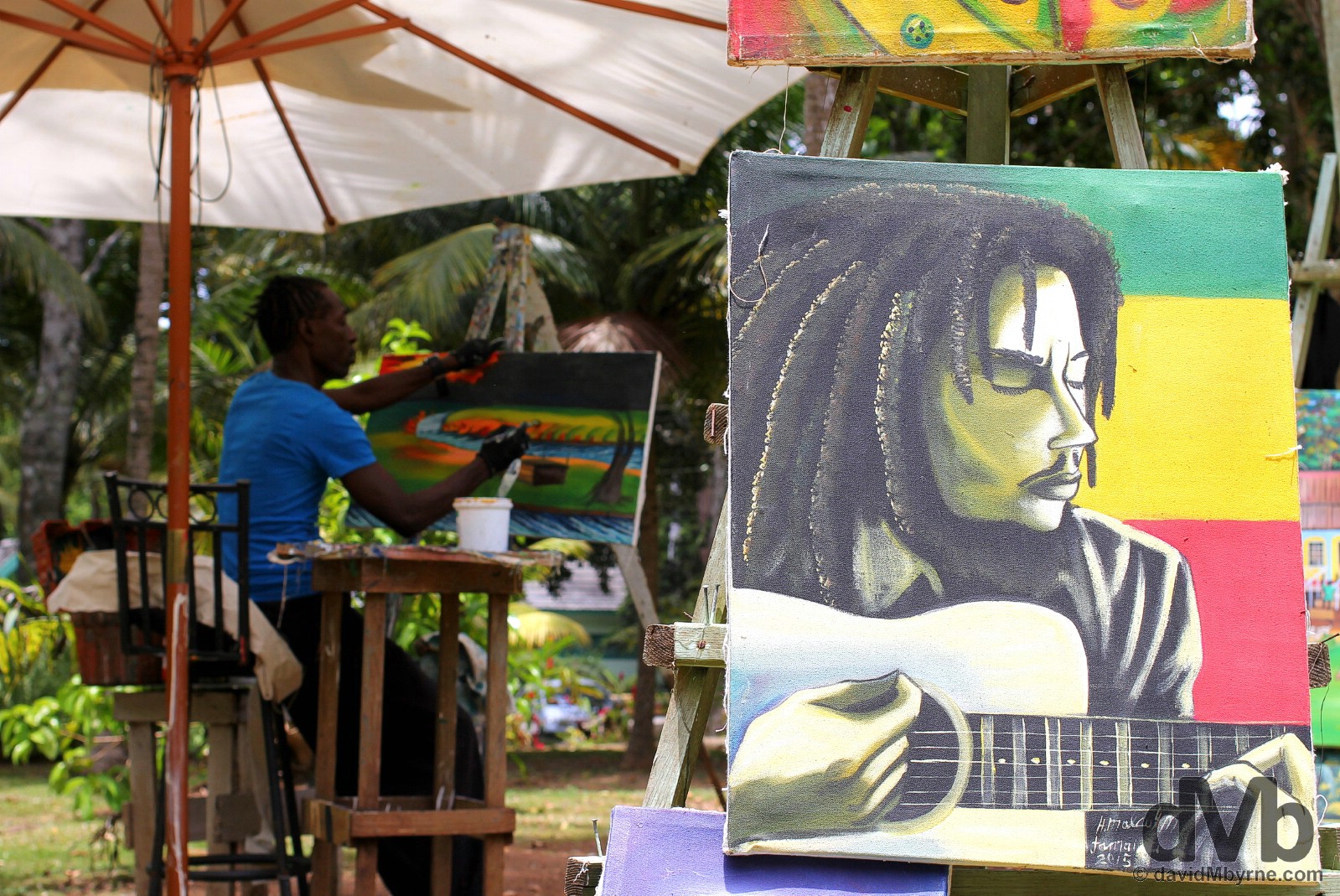
Bob for sale. Dunns River Falls, northern Jamaica. May 15, 2015.
Marley’s music was heavily influenced by the social issues of his homeland, and he is considered to have give voice to the specific political and cultural nexus of Jamaica. His best-known hits include ‘I Shot the Sheriff’, ‘No Woman, No Cry’, ‘Could You Be Loved’, ‘Stir It Up’, ‘Get Up Stand Up’, ‘Jamming’, ‘Redemption Song’, ‘One Love’ and ‘Three Little Birds’, as well as the posthumous release ‘Buffalo Solider’ and ‘Iron Lion Zion’. The compilation album Legend (1984), released three years after his death, is reggae’s best-selling album, going ten time Platinum, which is also known as one Diamond in the US, and selling 25 million copies worldwide.
While flying from Germany to Jamaica, Marley’s vital functions worsened. After landing in Miami, Florida, he was taken to the hospital for immediate medical attention. He died at Cedars of Lebanon Hospital in Miami (now University of Miami Hospital) on the morning of May 11 1981, at the age of 36. The spread of melanoma to his lungs and brain caused his death. His final words to his son Ziggy were “Money can’t buy life”. Marley received a state funeral in Jamaica on May 21 1981, which combined elements of the Ethiopian Orthodoxy and Rastafari tradition. He was buried in a chapel near his birthplace with his red Gibson Les Paul (some accounts say it was a Fender Stratocaster).
His voice was an omnipresent cry in our electronic world. His sharp features, majestic looks, and prancing style a vivid etching on the landscape of our minds. Bob Marley was never seen. He was an experience which left an indelible imprint with each encounter. Such a man cannot be erased from the mind. He is part of the collective consciousness of the nation.
– Reproduced from an infoboard at Dunns River Falls outside Ocho Rios, northern Jamaica.
Dunns River Falls
Jamaica’s best natural wonder is also its most visited and most commercialised attraction, a rather unique series of small limestone cataracts that form a natural stairway from sea to summit.
I hadn’t initially planned on visiting Dunns River Falls, 4 kilometres west of Ocho Rios on the island’s north coast. But I stopped off en route from the coast back to Kingston mostly out of curiosity. I’d heard of the attraction, but little else. I thought it to be a waterfall (obviously) and while that’s exactly what it is (more a set of waterfalls), I didn’t expect to have to pay US$20 to see it and nor did I expect to discover Jamaica’s best natural wonder to be the commercialised tourist circus that it undeniably is. In hindsight, I probably should have known better.
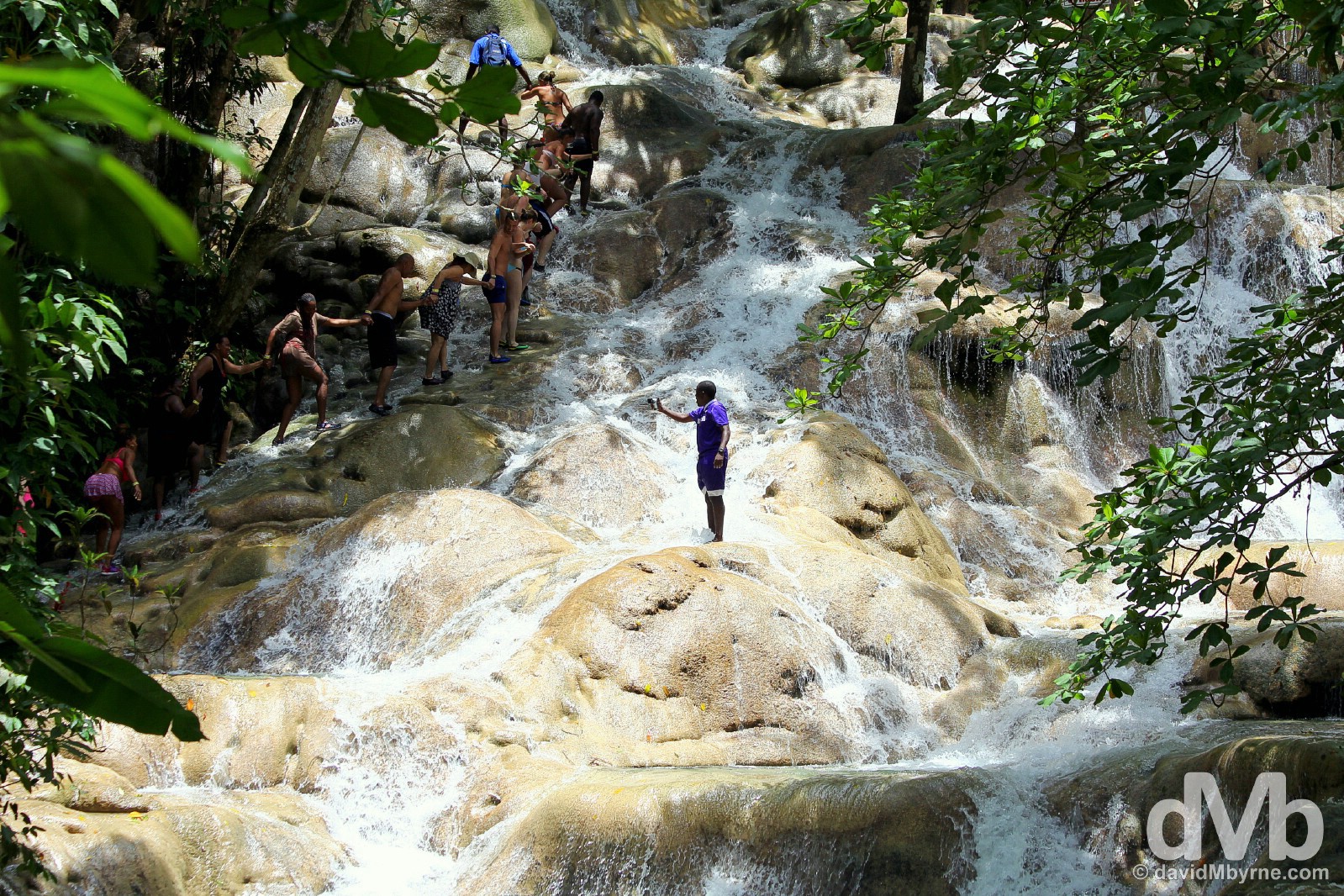
Dunns River Falls, outside Ocho Rios, northern Jamaica. May 15, 2015. || The gentle terraced cataracts of Dunns River Falls that run to the sea under a canopy of tropical forest is Jamaica’s highest-grossing tourist attraction; it’s very busy, very commercialised & I’d imagine a nice little earner. Everyone who comes here pays the equivalent of US$20 to link hands & tackle a natural watery staircase of limestone in groups led by joke-cracking, video camera-toting guides – the sea-to-summit assault, having an altitude gain of only 180 metres, typically takes about 90 minutes. At times the sight of lines of dozens of tourists snaking up the falls, not to mention the abundance of tacky tourist tat on sale in the expansive gardens surrounding the falls themselves, means the whole place can resemble a theme park rather than what it actually is, Jamaica’s best natural wonder. But it all seems like fun and the hordes seem to enjoy it. I stayed out of the water, happy instead to snap from a distance; above all else, it’s a very picturesque scene.
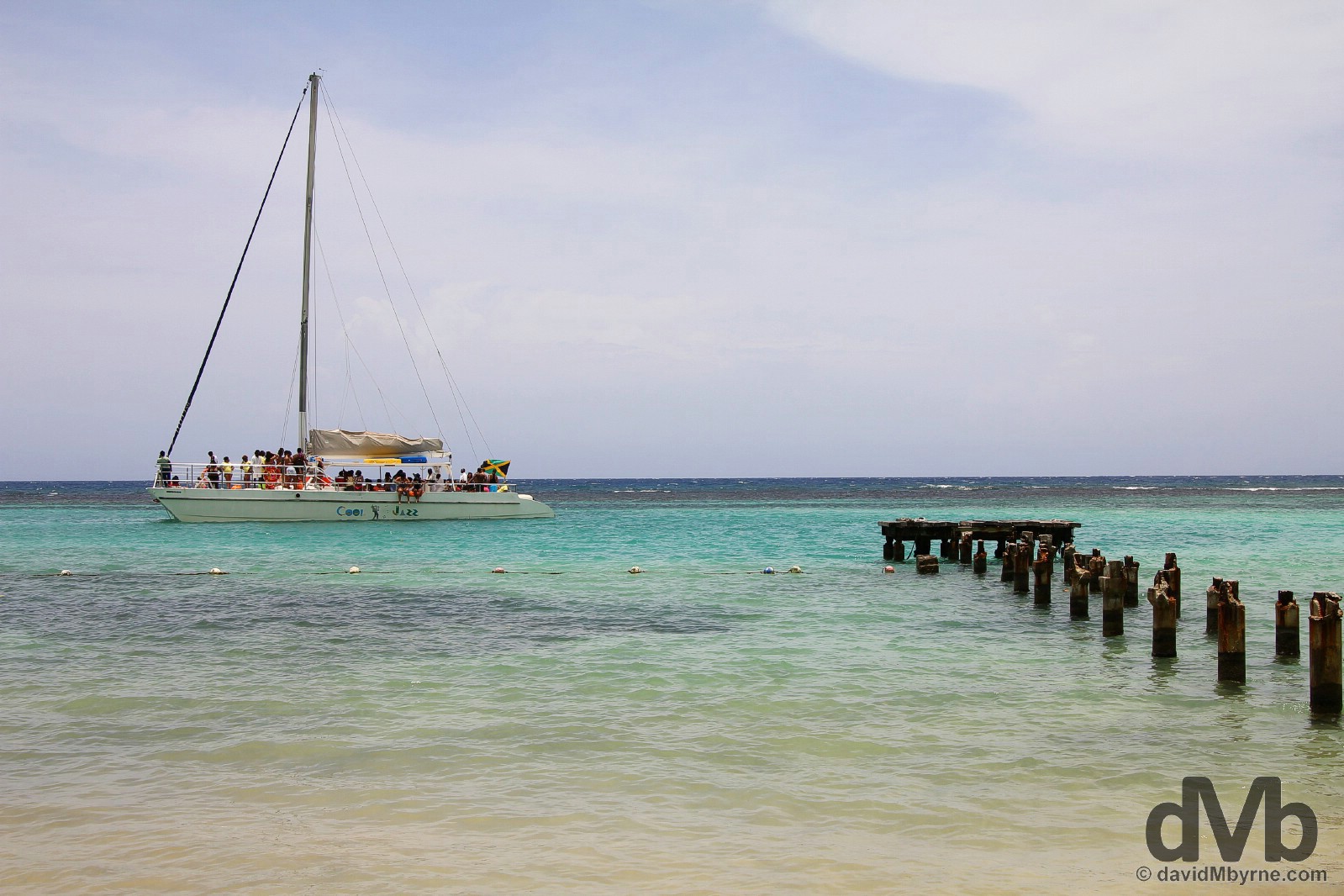
A party catamaran offshore of Dunns River Falls, northern Jamaica. May 15, 2015.
Caribbean Island Hopping || Jamaica To Haiti
My Caribbean island hop continued post Jamaica with a short twin-prop InterCaribbean flight across the Caribbean Sea to Port-Au-Prince, Haiti, the poorest country in the Western Hemisphere. And what an eyeopener that was to prove to be.
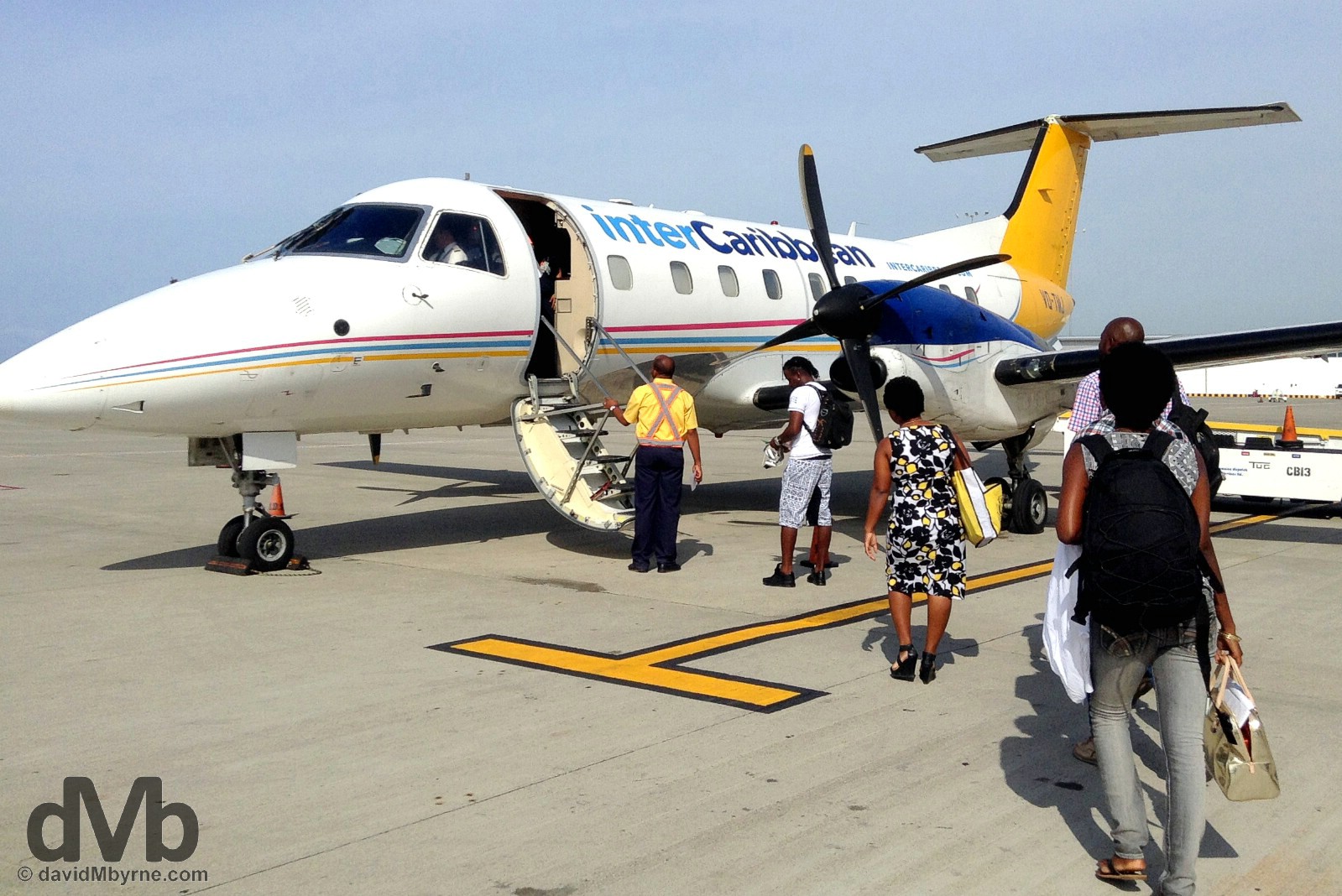
Boarding with the other 4 passengers of InterCaribbean flight JY623 to Port-Au-Prince, Haiti. Norman Manley International Airport, Kingston, Jamaica. May 16, 2015.
